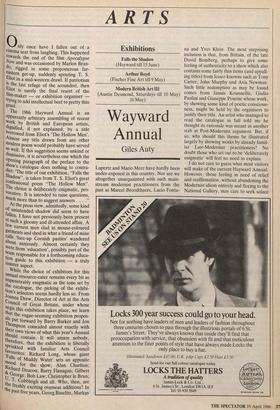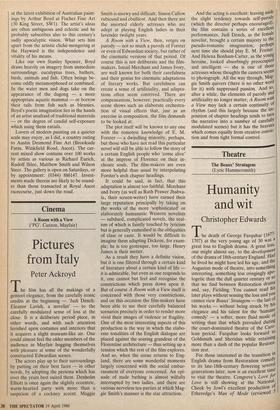ARTS
Exhibitions
Falls the Shadow (Hayward till 15 June) Arthur Boyd (Fischer Fine Art till 9 May) Modern British Art III (Austin Desmond, Saturdays till 10 May) 10 May)
Wayward Annual
Giles Auty
Only once have I fallen out of a cinema seat from laughing. This happened towards the end of the film Apocalypse Now and was occasioned by Marlon Bran- do, rigged in some preposterous far- eastern get-up, suddenly spouting T. S. Eliot in a mid-western drawl. If patriotism is the last refuge of the scoundrel, then Eliot is surely the final resort of the film-maker — or exhibition organiser trying to add intellectual beef to pretty thin gruel.
The 1986 Hayward Annual is an apparently arbitrary assembling of recent work by British and European artists, dignified, if not explained, by a title borrowed from Eliot's 'The Hollow Men'. Almost any title drawn from any other modern poem would probably have served as well. If this suggestion seems unkind or dismissive, it is nevertheless one which the opening paragraph of the preface to the show's catalogue does nothing to contra- dict: 'The title of our exhibition, "Falls the Shadow", is taken from T. S. Eliot's great confessional poem "The Hollow Men". The choice is deliberately enigmatic, pro- vocative. It is intended to raise questions, much more than to suggest answers . . . ." At the press view, admittedly, some kind of unintended •shadow did seem to have fallen. I have not previously been present at such a gloomy and ill-attended affair. A few earnest men clad in mouse-coloured garments and shod in what a friend of mine calls lace-up Cornish pasties' wandered about anxiously. Almost certainly they were from 'education', possibly part of the team responsible for a forthcoming educa- tion guide to this exhibition — a truly sinister aspect. While the choice of exhibitors for this annual resource-eater remains every bit as 'penetrably enigmatic as the tone set by the catalogue, the picking of the exhibi- !tem's selectors seems hardly less so. From Joanna Drew, Director of Art at the Arts Council of Great Britain, under whose aegis this exhibition takes place, we learn that the vague-seeming exhibition propos- als put forward by Barry Barker and Jon Thompson coincided almost exactly with their own views of what this year's Annual should contain. It will amaze nobody, therefore, that the exhibition is liberally sprinkled with familiar Arts Council favourites: Richard Long, whose giant `Falls of Muddy Water' sets an apposite mood for the show; Alan Charlton; Richard Deacon; Barry Flanagan; Gilbert & George; Bob Law; Christopher le Brun; U. T. Cobbleigh and all. Who, then, are the freshly exciting overseas additions? In the past five years, Georg Baselitz, Markus Lupertz and Mario Merz have hardly been under-exposed in this country. Nor are we altogether unacquainted with such main- stream modernist practitioners from the past as Marcel Broodthaers, Lucio Fonta- na and Yves Klein. The most surprising inclusion is that, from Britain, of the late David Bomberg, perhaps to give some feeling of authenticity to a show which also contains some fairly thin items (and appall- ing titles) from lesser-knowns such as Tony Carter, John Murphy and Avis Newman. Such little redemption as may be found comes from Jannis Kounnellis, Giulio Paolini and Giuseppe Penone whose work, by showing some kind of poetic conscious- ness, might be held by the organisers to justify their title. An artist who managed to read the catalogue in full told me he thought its rationale was meant as another stab at Post-Modernist argument. But, if so, why should this theme be illustrated largely by showing works by already famil- iar Late-Modernist practitioners? No doubt those who set out to be 'deliberately enigmatic' will feel no need to explain.
I do not care to guess what most visitors will make of the current Hayward Annual. However, those feeling in need of relief and reaffirmation, without abandoning the Modernist idiom entirely and fleeing to the National Gallery, may care to seek solace at the latest exhibition of Australian paint- ings by Arthur Boyd at Fischer Fine Art (30 King Street, SW1). The artist's ideas are often ambiguous and eclectic and he probably subscribes also to this century's sadly apocalyptic vision. What sets him apart from the artistic clichd-mongering at the Hayward is the independence and vitality of his means.
Like our own Stanley Spencer, Boyd draws heavily on imagery from immediate surroundings: eucalyptus trees, bathers, birds, animals and fish. Often beings be- come oddly metamorphosed or combined. In the water men and dogs take on the appearance of the dugong — a more appropriate aquatic mammal — or borrow their tails from fish such as blennies. Boyd's poetic imagination lies in the hands of an artist unafraid of traditional materials — or the degree of candid self-exposure which using them entails.
Lovers of modern painting on a quieter scale may enjoy, as I did, a country outing to Austin Desmond Fine Art (Brookside Farm, Winkfield Road, Ascot). The cur- rent mixed show contains over 100 works by artists as various as Richard Eurich, Rudolf Ihlee, Matthew Smith and Wilson Steer. The gallery is open on Saturdays, or by appointment: (0344) 886147. Invest- ments made therein are likely to be sound- er than those transacted at Royal Ascot racecourse, just down the road.



















































 Previous page
Previous page